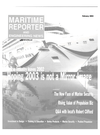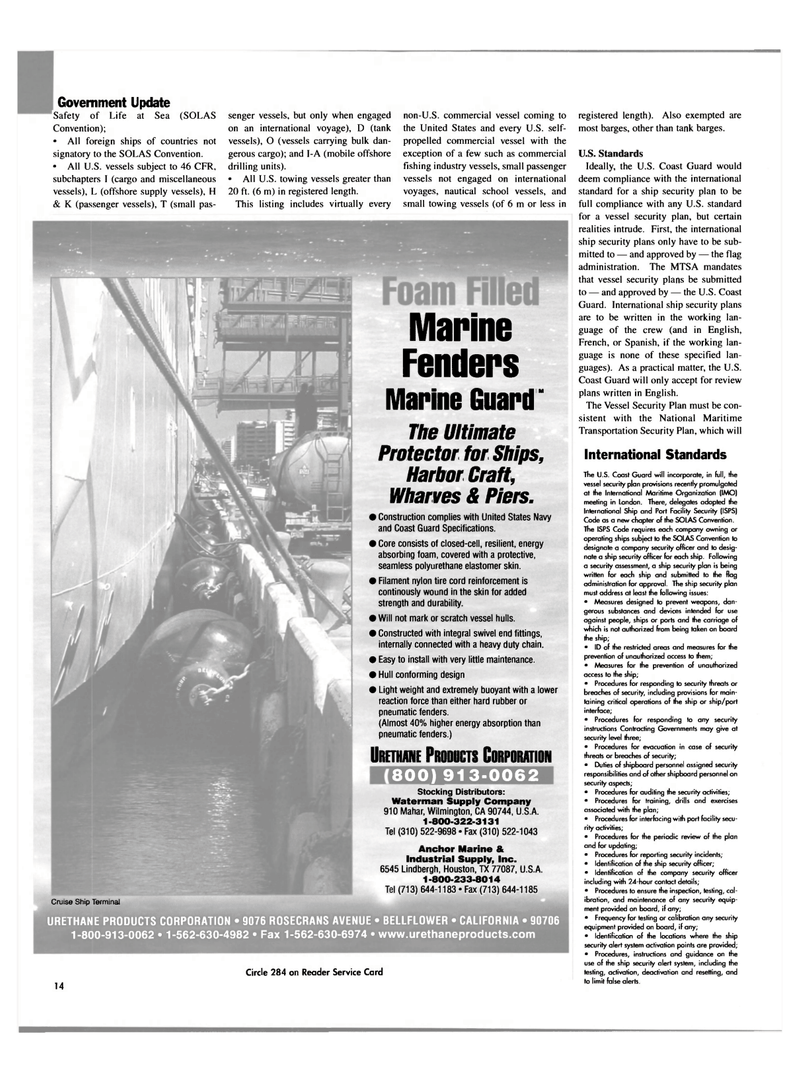
Page 14: of Maritime Reporter Magazine (February 2003)
Read this page in Pdf, Flash or Html5 edition of February 2003 Maritime Reporter Magazine
• Constructed with integral swivel end fittings, internally connected with a heavy duty chain. • Easy to install with very little maintenance. • Hull conforming design • Light weight and extremely buoyant with a lower reaction force than either hard rubber or pneumatic fenders. (Almost 40% higher energy absorption than pneumatic fenders.)
URETHANE PRODUCTS CORPORATION 800) 913-0062
Cruise Ship Terminal
Anchor Marine &
Industrial Supply, Inc. 6545 Lindbergh, Houston, TX 77087, U.S.A. 1 -800-233-8014
Tel (713) 644-1183 • Fax (713) 644-1185
URETHANE PRODUCTS CORPORATION • 9076 ROSECRANS AVENUE • BELLFLOWER • CALIFORNIA • 90706 1-800-913-0062 • 1-562-630-4982 • Fax 1-562-630-6974 • www.urethaneproducts.com
Government Update
Safety of Life at Sea (SOLAS
Convention); • All foreign ships of countries not signatory to the SOLAS Convention. • All U.S. vessels subject to 46 CFR, subchapters I (cargo and miscellaneous vessels), L (offshore supply vessels), H & K (passenger vessels), T (small pas- senger vessels, but only when engaged on an international voyage), D (tank vessels), O (vessels carrying bulk dan- gerous cargo); and I-A (mobile offshore drilling units). • All U.S. towing vessels greater than 20 ft. (6 m) in registered length.
This listing includes virtually every non-U.S. commercial vessel coming to the United States and every U.S. self- propelled commercial vessel with the exception of a few such as commercial fishing industry vessels, small passenger vessels not engaged on international voyages, nautical school vessels, and small towing vessels (of 6 m or less in
Marine Fenders
Marine GuardM
The Ultimate
Protector for Ships,
Harbor Craft,
Wharves & Piers. registered length). Also exempted are most barges, other than tank barges.
U.S. Standards
Ideally, the U.S. Coast Guard would deem compliance with the international standard for a ship security plan to be full compliance with any U.S. standard for a vessel security plan, but certain realities intrude. First, the international ship security plans only have to be sub- mitted to — and approved by — the flag administration. The MTSA mandates
Stocking Distributors:
Waterman Supply Company 910 Mahar, Wilmington, CA 90744, U.S.A. 1-800-322-3131
Tel (310) 522-9698 • Fax (310) 522-1043 • Construction complies with United States Navy and Coast Guard Specifications. • Core consists of closed-cell, resilient, energy absorbing foam, covered with a protective, seamless polyurethane elastomer skin. • Filament nylon tire cord reinforcement is continously wound in the skin for added strength and durability. • Will not mark or scratch vessel hulls. that vessel security plans be submitted to — and approved by — the U.S. Coast
Guard. International ship security plans are to be written in the working lan- guage of the crew (and in English,
French, or Spanish, if the working lan- guage is none of these specified lan- guages). As a practical matter, the U.S.
Coast Guard will only accept for review plans written in English.
The Vessel Security Plan must be con- sistent with the National Maritime
Transportation Security Plan, which will
International Standards
The U.S. Coast Guard will incorporate, in full, the vessel security plan provisions recently promulgated at the International Maritime Organization (IMO) meeting in London. There, delegates adopted the
International Ship and Port Facility Security (ISPS)
Code as a new chapter of the SOLAS Convention.
The ISPS Code requires each company owning or operating ships subject to the SOLAS Convention to designate a company security officer and to desig- nate a ship security officer for each ship. Following a security assessment, a ship security plan is being written for each ship and submitted to the flag administration for approval. The ship security plan must address at least the following issues: • Measures designed to prevent weapons, dan- gerous substances and devices intended for use against people, ships or ports and the carriage of which is not authorized from being taken on board the ship; • ID of the restricted areas and measures for the prevention of unauthorized access to them; • Measures for the prevention of unauthorized access to the ship; • Procedures for responding to security threats or breaches of security, including provisions for main- taining critical operations of the ship or ship/port interface; • Procedures for responding to any security instructions Contracting Governments may give at security level three; • Procedures for evacuation in case of security threats or breaches of security; • Duties of shipboard personnel assigned security responsibilities and of other shipboard personnel on security aspects; • Procedures for auditing the security activities; • Procedures for training, drills and exercises associated with the plan; • Procedures for interfacing with port facility secu- rity activities; • Procedures for the periodic review of the plan and for updating; • Procedures for reporting security incidents; • Identification of the ship security officer; • Identification of the company security officer including with 24-hour contact details; • Procedures to ensure the inspection, testing, cal- ibration, and maintenance of any security equip- ment provided on board, if any; • Frequency for testing or calibration any security equipment provided on board, if any; • Identification of the locations where the ship security alert system activation points are provided; • Procedures, instructions and guidance on the use of the ship security alert system, including the
Circle 284 on Reoder Service Card testing, activation, deactivation and resetting, and , - to limit false alerts. 14

 13
13

 15
15
